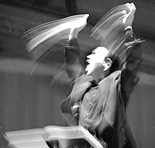

In an open forum Tuesday, Tan Dun spoke about the composition of his recently premiered opera, Marco Polo. "How could I develop my language through the culture we experience?" asked Tan eight years ago.
Through a blending of techniques, idiom, and images from Eastern and Western musical culture, Tan has constructed his own personal and very powerful musical language. Not simply a technical fusion of distantly related genres, Tan has mastered each form with deep knowledge and understanding, and combined them to his conception of musical expression.

The Western techniques with which we are familiar are not strikingly different from what would appear on any other Contemporary program, but a distinct emotional content is quite evident. To quote Tan on introductory notes found in his Colors for String Quartet, "I began to find a way to mingle old materials with new to contribute something to the western idea of atonality and refresh it. I find a danger in later atonal writing that it is too easy to leave oneself out of the music. I want to find ways to remain open to my culture and open to myself."
Each of the pieces on the program Wednesday evening was marked by its emotional quality and the sheer compositional strength of its conception. The program surveyed the work of a mature composer in the development of a new dialect. The Contemporary Music Ensemble, Oberlin Percussion Group, and various soloists including Tan himself performed each work with care to detail and great feeling.
Opening the concert was the trio In Distance for piccolo, harp, and bass drum. Tan's treatment of the instruments was Eastern, "The piccolo is treated more like the Chinese bamboo flute, the harp is treated like the Koto, and the bass drum is made to sound like Indian Drums." Although size and color might suggest more of a chamber ensemble-like setting for In Distance, the vigor and dynamic fit well in the larger venue of Finney Chapel.
Following was Silk Road, for percussion and Soprano. The text is an excerpt from poet Arthur Sze's "The Silk Road" set to the textural backdrop of percussion. Writes Tan about Silk Road, "The rhythms of English verses are combined with the tonal qualities of Peking Opera, in a linear structure like the connected brush-strokes of calligraphy." Soprano conservatory senior Rebecca Garcia and percussionist double-degree senior Chris Santiago executed the work with technical grace and dexterity providing the audience with a novel textural experience.
Concerto for Pizzicato Piano and Ten Instruments, with first-year Jacob Greenburg as piano soloist, closed the first half. Based on the motive C-A-G-E, the tribute to John Cage featured interesting work by flutist double-degree first-year Jara Kern involving movement around the ensemble (arranged in a circle) and playing into the undampened piano causing sympathetic vibrations. The concerto had a somewhat dance like quality to it that was enhanced by the arrangement of the instruments and the texture of the pizzicato piano.
Conducting the "Circle for Four Trios," "Conductor," and "Audience" was Tan himself. Sound effects furnished by the audience on cue from the conductor during the piece lent a certain spaciousness in addition to the arrangement of the trios around the balcony of Finney Chapel. The directional sound provided by the set up was quite novel and effective, thus accenting the content suggestive of introspection and subdued emotion.
"Elegy: Snow in June" provided an intensely emotional and dramatic end to the program. Accompanying faculty member Andor Toth on cello were four percussionists conducted by Michael Rosen, professor of percussion. Paired with imagery from a thirteenth century Chinese drama detailing the injustice done to a young woman, Tan describes his piece as "sparse, searching phrases, it coalesces to the theme which is found in the middle, and then disperses again." The middle theme was a truly fervent combination of the cello and all four percussionists at high volume and rhythmic intensity; the cello was kept in its rich higher register and accompanied by traditional and non-traditional percussion effects. The power and content of the individual work - and the evening as a whole - was not lost on anyone in the concert hall.
The reason for Tan's brief residency are now quite clear: he is an extremely encouraging figure in music today. Tan challenges audiences with new musical arguments that are presented in a highly accessible way, in addition to exposing them to new cultural and spiritual material. His music has a beautiful level of detail, intricacy and complexity without sacrificing the cohesiveness of form nor the power of emotional expression.
Tan is able to bring contrasting genres together in a fresh and agreeable idiom envisioning new opera as the future of performance art. Tan is truly a composer of the information age in which there are no longer boundaries to the exchange and dispersal of cultural and musical material. Says Tan, "I just wanted to share my musical experience with everybody." Clearly he has accomplished just that.
Copyright © 1997, The Oberlin Review.
Volume 126, Number 9, November 14, 1997
Contact us with your comments and suggestions.